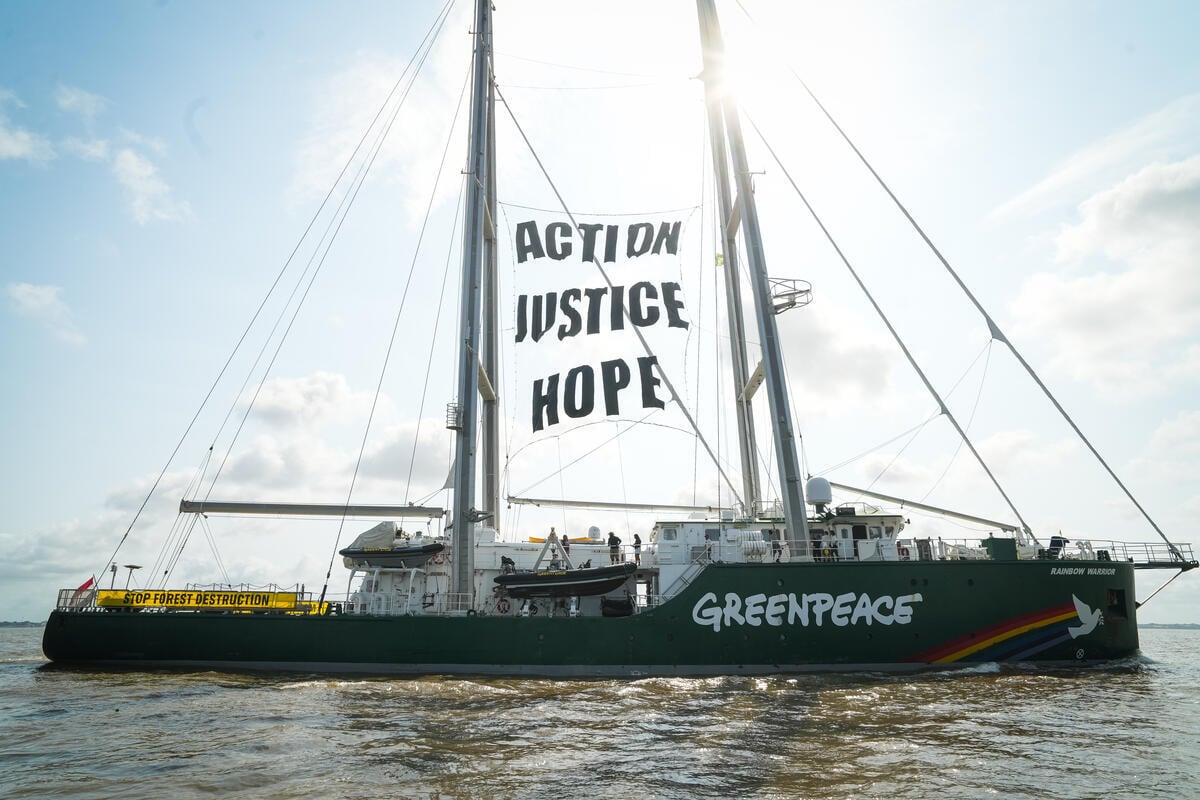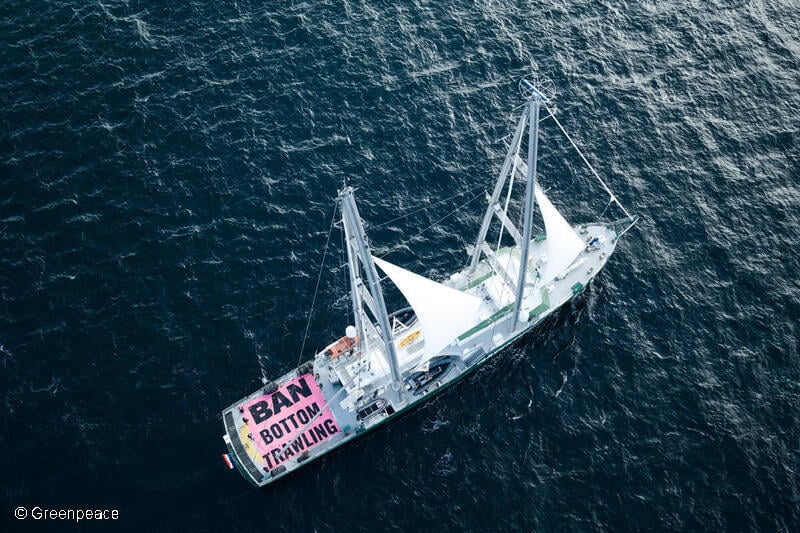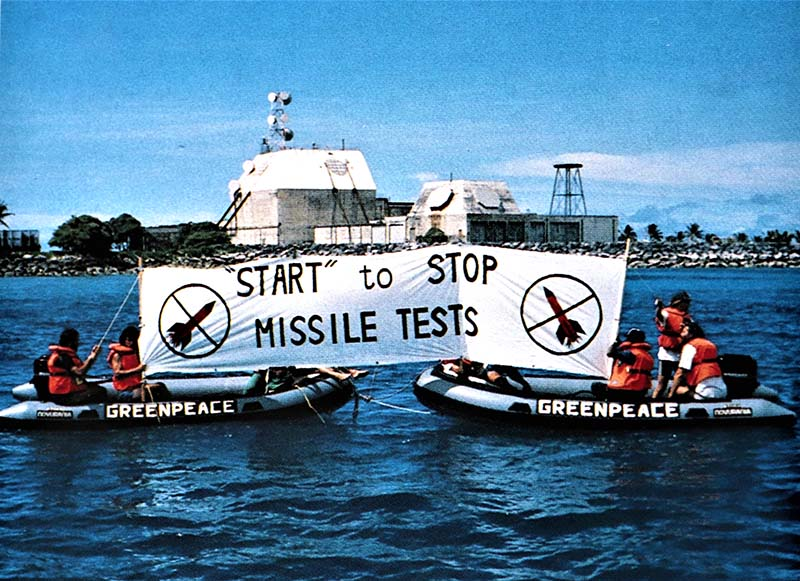In April 2025 some of the Greenpeace crew visited Matauri Bay, Northland, the final resting place of the original flagship, the Rainbow Warrior.

Generations of Greenpeace staff have been visiting the memorial site since it was sunk as a diving wreck in 1986.
On this trip – almost forty years exactly since its bombing by French Government agents – we took part in many activities: doing up the track up to the memorial, diving onto the wreck, visiting a local school and learning more about the events on that last voyage all those years ago.
Here four of our crew, Moira, Emma, Fleur and Juan, share personal reflections on what made the visit so special.
Table of contents
Diving the Rainbow Warrior
Juan Parada, Oceans campaigner
My main task on our trip to Matauri Bay, among the many tasks that everyone was meant to do, was diving the Rainbow Warrior wreck, which is now an artificial reef for the fishes and the creatures down there to live in.
I was excited to do it because first of all I love diving, and it was such a privilege to have the opportunity to check out the wreck of the original Rainbow Warrior. It has such a big connection to the history of Greenpeace and New Zealand.
It was a moment to visit the original Rainbow Warrior, which was sunk there in Matauri Bay after the bombing attack. But the other reason to do the dive was to take some pictures of the wreck, of us diving on it and sharing our campaign messages underwater to highlight this moment the organisation is going through right now.
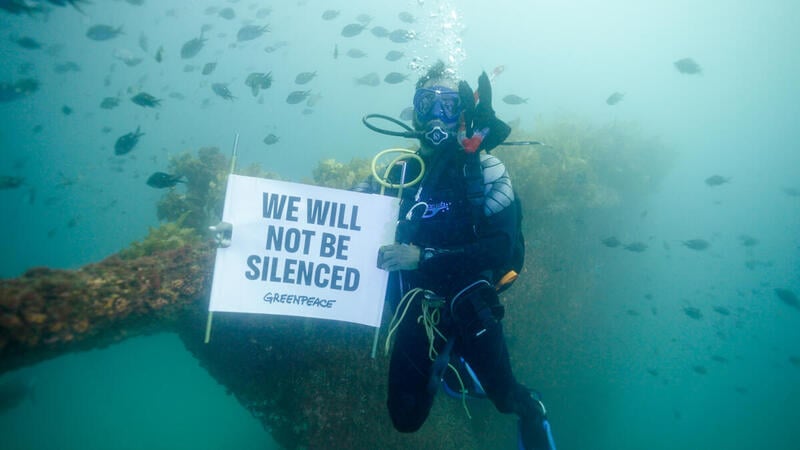
With the SLAPP lawsuit (which is currently threatening the existence of the US Greenpeace office) we thought we could capture powerful images that connect back to our history and the upcoming 40th anniversary of the bombing of the Rainbow Warrior.
Diving there was really special for me. Diving is by itself a spiritual experience! You’re almost weightless when diving, and that’s magical. You enter this whole different world where everything moves differently, sounds different and feels different.
And in this particular case, just being down there and seeing the boat, or what remains of it, was almost mystical.
Thinking of my own onboard experience
I had the experience earlier this year to be on the current Rainbow Warrior (Rainbow Warrior III). Spending some time there taking part in the on board training was a really important, enriching experience for me. I learned how the boat works and how the activists live inside the boat.
I couldn’t help but to connect that experience to the boat I saw underwater. Even though they’re different boats, they’re similar. They have the same basic arrangement as any boat.
The wreck is still pretty recognisable as a boat even though it’s deteriorated with the time. There are loose pieces that look like they’re eventually going to collapse. It’s still pretty easy to tell where the living quarters are, where’s the deck, where’s the railing, where’s the bridge of the boat or the bow and the stern.
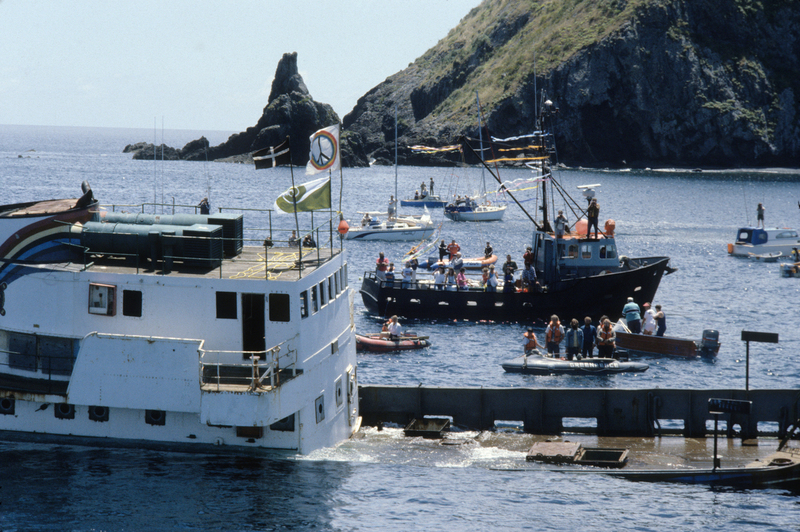
We also saw the bomb holes, they’re massive, pretty much car-sized. You could go inside them but we didn’t because it was an extra level of risk that wasn’t necessary. Instead we peeked inside where all the fishes are hiding.
It was powerful to see the damage that sank the boat and, and to see it in this new context, because it’s now like a door, the entrance of this hidey hole where the fish feel safe.
I could imagine myself and my fellow activists in this boat doing the activities that we did in the campaign training. I felt a powerful connection to the people that came before us in the organisation and their legacy, the work they did, the campaigns they worked on, and the challenges that they faced.
A challenge from the past
I felt we’re continuing this work that started with these people before us, and for which some of them even gave their lives – Fernando Pereira in particular died doing this, the ultimate sacrifice. We don’t need to die for it, but we need to be courageous and we need to uphold those values and that mana, that strength.

Even though this boat was attacked and bombed, and the intention of the French Government was no doubt to to stop their campaigning, to shut Greenpeace up and go ahead with their nuclear testing undisturbed – they didn’t succeed. The bombing did the opposite, it supercharged anti-nuclear sentiment [eventually leading to the Comprehensive Test Ban Treaty in 1996].
The boat itself, damaged and unusable as a boat, became the home for all these amazing creatures, a hub of life and diversity.
Being on the final voyage of the Rainbow Warrior
That same evening we listened to David Robie talk about that last voyage, 40 years ago today. That was also really moving because it was my first time to meet anyone who had been part of the original Rainbow Warrior crew. He was onboard as a journalist and to hear him speak about his experience and the people that were there, all the things they did, brought it full circle for me.
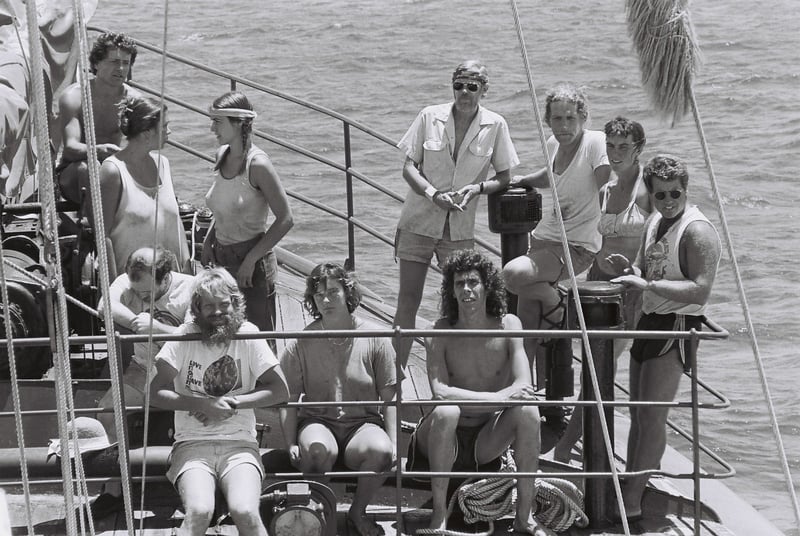
David was showing us the photos from the 80s, when they were all on the boat and were all just living, doing their work, evacuating the Marshallese people from their island. We saw the boat there as a setting. They weren’t specifically photos of the boat, it was just the place they were in.
But then we naturally connected it with what we saw on the wreck – the railing where we saw the eel, where we saw the fish, and in the photo they’re standing there. It brought home the meaning of it, the historical significance and the reality that David was there too. It was kinda trippy to think he was on the boat when it was a boat.
We gave a little account of our dive experience and while I was speaking I saw David was paying so much attention! It felt like a real privilege that he cared about our experience too.
Because I was out diving I didn’t get to go with everyone else to the talk about the memorial itself. But the next morning when I woke up I went there by myself and climbed to the top of the maunga. So I went from the ship on the floor of the ocean to the memorial on the top of the hill. In between the height and the depth there is all of us, and there is this precious blue world that we want to protect. It felt really poetic and beautiful.
The story of the journalist on the last voyage, David Robie
Emma Page, Oceans Communications Lead
I was on the track maintenance team, on the middle level. We were mostly cleaning up the waterways. I was with my son Wilbur who’s 11, and he was there with his friend Frankie, who’s twelve, and they were also knee deep in digging out all of the weeds.
It was my first time at Matauri Bay. One of the things it made me really think about, which is not only specific to the oceans campaign I work on, was really feeling for the first time what being part of Greenpeace as a community or a movement or family means and feels like.
Looking back 40 years
David Robie gave us a really great presentation of what it was like on board the Rainbow Warrior as a freelance journalist on that final voyage in 1985. David’s a journalist and was actually one of my journalism lecturers when I went to journalism school, like 15 plus years ago!
At that time he was reporting on the journey to Rongelap and helping the people move from their island home.
When you’re hearing people like David talking about being on that last voyage and sharing those memories – then thinking about how all of us here now are continuing the work – and that in the future, there will be people who join and keep campaigning for oceans and for all the other issues that we work on – I had this really tangible feeling of how it all fits together.
The work goes behind us and before us – I think I described it in my reflection on the day, ‘looking back and moving forward’. And that it’s bigger than me right now or bigger than all of us right now.
Russel [Norman, Executive Director] said it in a way too, about feeling the challenge from the past when you’re looking at those photos of the people who were on that last voyage, and the really brave work that they did. You see them looking out at you and it does feel motivational, but also like a challenge to keep being courageous.
We can get caught up in the everyday of trying to do something. And this was one of those moments where you get more of a bird’s eye view, and that felt significant.
Connecting with the people in the photos
I think one of the most moving things was hearing David talk about the people in the photographs, making them come alive with the stories of the people and what they were like, including when he talked about that photo that best represented Fernando sitting on a boat with his camera in mid-conversation.
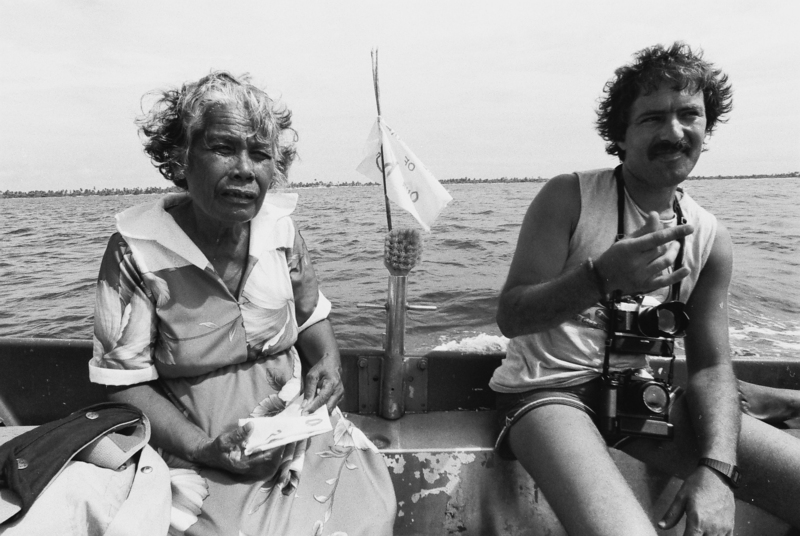
David has written in his book about being on the Rainbow Warrior (Eyes of Fire), putting it in the political context of the time.
He talked to us about the difficulties and all the challenges back 40 years ago, getting content to the media from a boat, and sending radio reports – how important it was to get the story out there.
The Greenpeace photographer – that was Fernando – would have to develop the photos himself on board, then transmit them to media outlets. He was one of the people who was key in getting the story of that final voyage to the media and to the wider public.
I found it interesting also talking with David about the different struggles for journalism training these days – there’s less outlets now to train as a journalist in New Zealand. That’s because there’s less jobs and there’s so much pressure on the media at the moment. Lots closing down, people losing their jobs and then the impact of that in terms of being able to get stories out.
The incredible vision of sculptor Chris Booth
Fleur Auber, Finance Manager
Along with everyone I went to support Greenpeace and our mission of reconnecting with Ngāti Kura and with the place, Matauri Bay, because we hadn’t been up there for so long.
I hadn’t been up to Matauri Bay before so it was really amazing seeing it in person, because I’ve seen lots of pictures of it since working with Greenpeace and heard all about it. Also I appreciated just connecting with each other in that special place.
I helped with the maintenance work that needed to be done on the track. I’m in awe of everyone who worked on the track for the whole morning, because that was hard work.
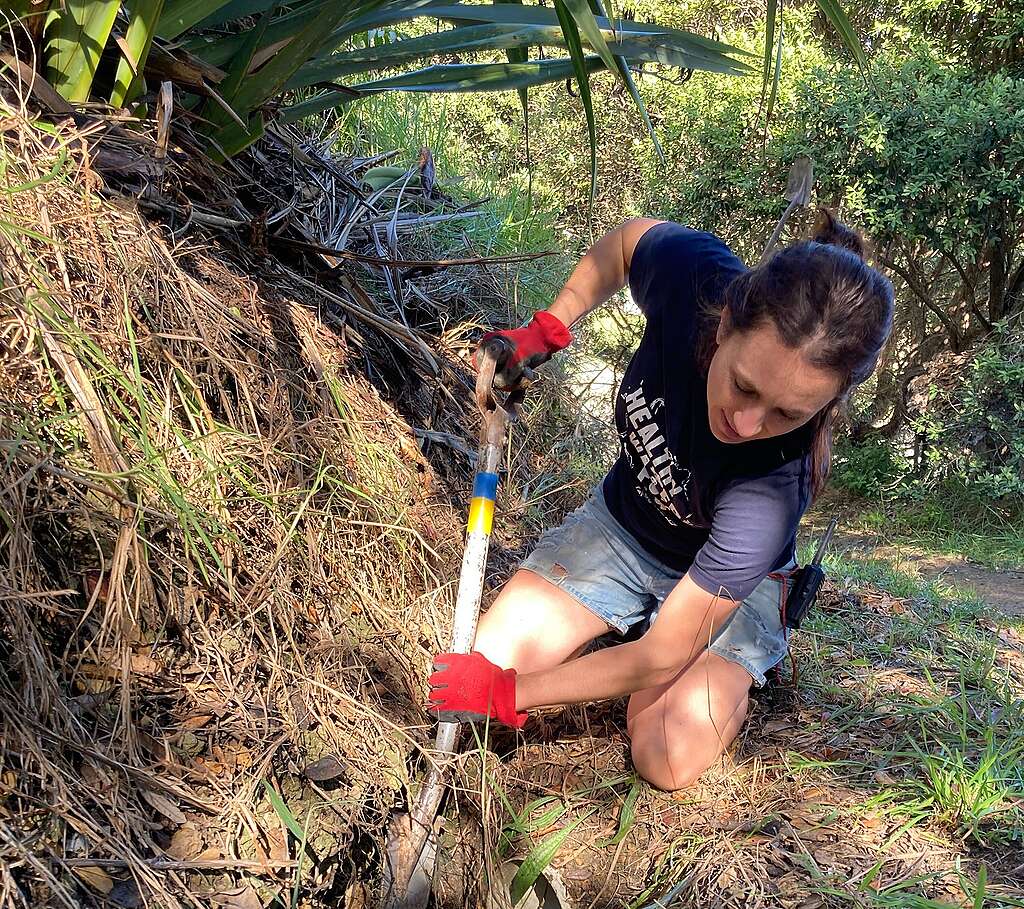
But on the day I ended up working on the stones at the top of the maunga, which are these beautiful stones laid on top of one another, and they contain the map and the directions pointing out to where the Rainbow Warrior is resting.
It was a pretty special piece of work. We were using a tool called a dremel, not to re-carve, but to redefine where the carving had faded, going over it to make it clearer so people can read it.
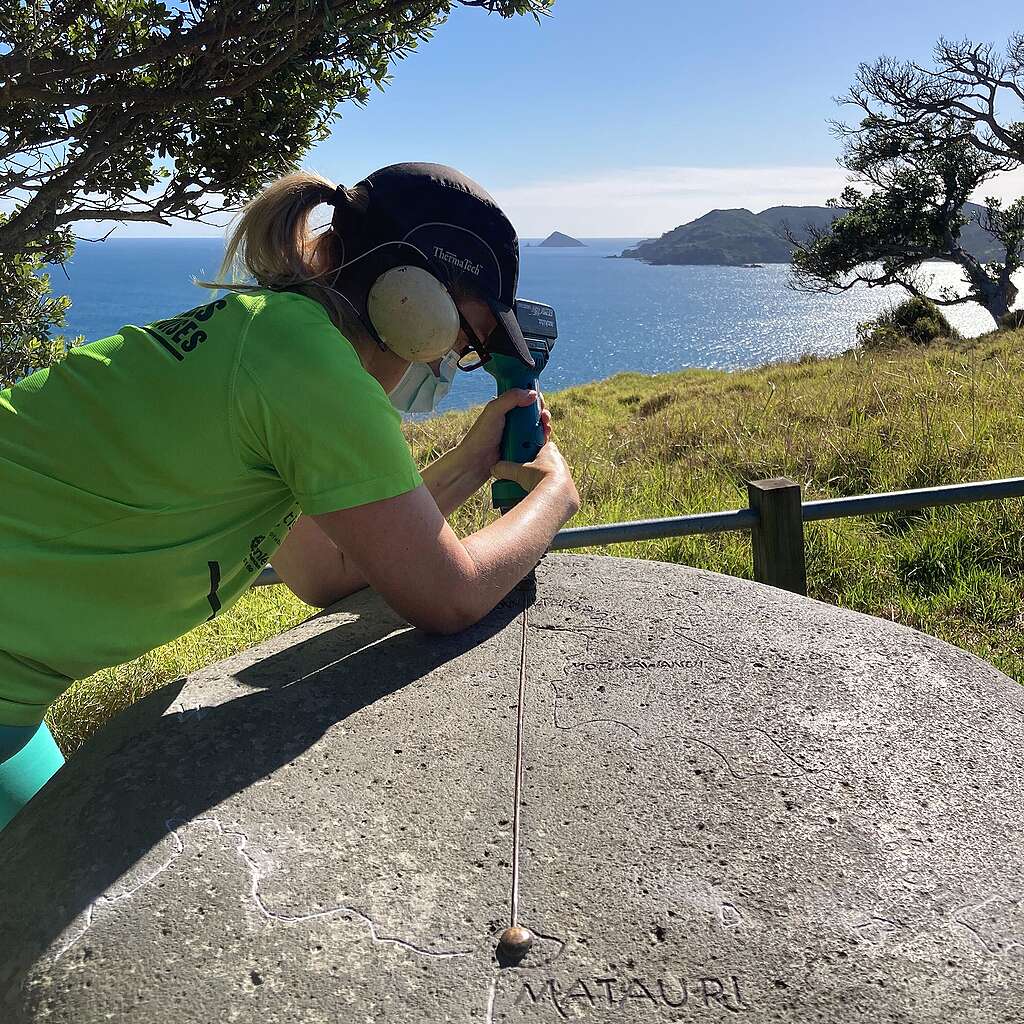
That was really cool and it was a beautiful place to work right next to the memorial on top of the maunga. It was just so beautiful, with such a beautiful outlook.
The memorial was bigger than I thought it was going to be. I had seen pictures of it but when you get up there and see it you realize the scale of it. It’s incredible.
When you see the memorial you think, ‘how is that all put together? Are they just hanging there, or is there something going through them to hold those stones together? How does it all work? How did they get those massive stones up there?’
And we got to hear the story and the history behind that which was pretty amazing. Chris Booth, the artist who did the sculpture, visited us on site to talk to us in person about how the work came about. And what a story!
It was incredible, the vision for it and how he put it together, all the work that went into creating it.
How did they make the memorial?
The work was created in conjunction with the local people, all of the stones were blessed when they were taking them. They tried to do it quite traditionally with more traditional tools and techniques.
Chris had found these beautiful large stones, two in particular, a couple of bays away from Matauri Bay. One of them weighed 4, or 4 and a half tons, and the other one and a half tons. They had to try and float them, and then tow them around closer to the site so they could get them up to the top of the maunga. To do that they tried flooding them with barrels when the tide came in.
But they had loads of issues and ropes got tangled around boat propellers, lots of drama! They ended up having to get larger vessels to bring up those stones.
They had to get lots of other smaller stones as well, make them all fit together and then get it up the top of the maunga.
There’s steel inside holding the stones together. It goes through the stones to create the shape of a rainbow. When you look at it you think it doesn’t look very sturdy, but actually it’s incredibly strong. I mean, the fact that it’s been there for coming up to 40 years now. It’s survived all sorts of weather.
A memorial that makes us look up
I’m not sure how you would do it today because of the stronger health and safety rules that we now have! I imagine you’d have to get a helicopter to do it. That’s the only way you could get those stones up there. Interestingly it was Wayne Brown [now Mayor of Auckland] who was the engineer for it!
Chris said he wanted it to be a positive sculpture. The circles on the top are to get people looking up, and apparently if you see at the right time of day the sun (or the moon) shines through it.
During his talk Chris happened to mention that the stones we had worked on earlier in the day to clean had been initially engraved by the New Zealand artist Ralph Hotere. I hadn’t specifically heard of him but I knew from people’s reaction that obviously he was very well-known!
Connecting with the people and the land
Moira Neho (Ngāti Hine, Ngāti Wai), Organisational Support Director
My role on the trip to Matauri Bay was to help with the overall coordination of the visit. I also led the catering team which isn’t always a simple task because there are a number of dietary requirements.
It’s really important to me that people are fed well, because hungry people are not happy people, and if you’re out of your comfort zone already and you’re hungry as well, then it’s not the greatest experience.
Why did Greenpeace visit Matauri Bay?
To give context for all the things we were doing at Matauri Bay we need to go back a little bit in terms of the history of Greenpeace Aotearoa.
After the Rainbow Warrior was bombed there was a question about what to do with the wreck. There were a series of conversations and as a result, the wreck rests off the coast of Matauri Bay. [Former MP] Dover Samuels (Ngāti Kura) was instrumental in the Warrior being laid to rest there and it was a privilege to hear directly from him on this visit.
Since that time, over the years, Greenpeace has gone back to reconnect with the land and mana whenua Ngāti Kura, and to help with maintenance of the track leading up to the memorial. Unfortunately, because of Covid-19, we haven’t been able to return since 2019 So there was a bit of work for us to do in reconnecting.
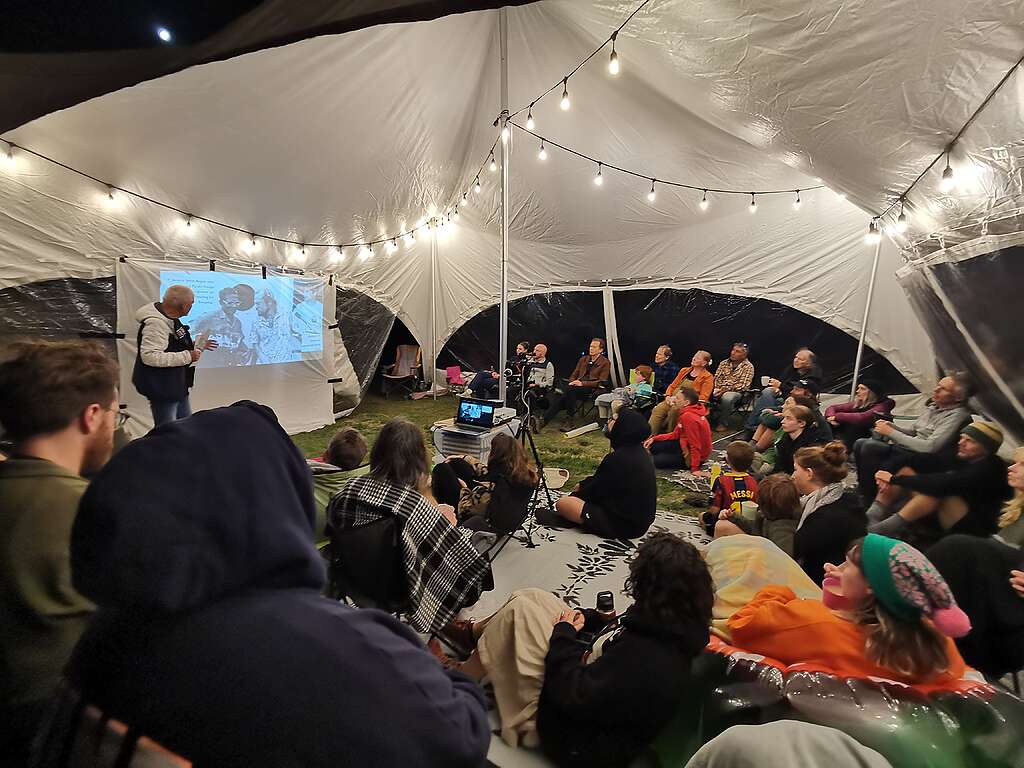
Remembering Fernando
So while we did a bunch of practical work, we also did some really important work of reconnecting with Ngāti Kura, who are kaitiaki and mana whenua of that place which is really special for us as Greenpeace.
Our time there started with a visit to the marae, where we were welcomed and were able to spend the evening with them, eating and chatting. It was here that matua Dover shared his experience of bringing the Rainbow Warrior to Matauri Bay and some of the memories of that day.
Seeing the picture of Fernando [Pereira] on the wall of their marae was in a way overwhelming. Fernando lost his life on the Rainbow Warrior when it was bombed. As part of a previous visit Greenpeace had gifted his picture to Ngāti Kura and they display it on the back wall of the marae along with their other ancestors and loved ones who have passed.
The marae Chair told me, ‘as soon as he was brought through those doors, he belonged to us’. To have him sit on that back wall with them is really special.
A special learning experience
Each year we have a staff wananga, and this year was the trip to Matauri Bay.
We really try to give our staff opportunities to expand their knowledge and confidence within te Ao Māori, or working with Māori. Over the years we’ve done a number of different things to increase our collective confidence with working within Te Ao Maori. Such as a combination of activities like going on marae, te reo classes, Te Tiriti workshops.
Before one of our first marae visits, we watched Tāmati Rimene-Sproat’s show From Hongi to Hangi, which gives people an idea of what to expect when visiting a marae. It is very informative, but it’s still just theoretical. Until you’ve actually had to do it, you don’t really get it.
It’s something different to be in the space and to have practical, hands-on experience of doing things, rather than just having a theoretical understanding of it.
Living into our values as an environmental organisation
It was really special being able to go this time and participate in powhiri and listen to what was shared by people who are from there. People who have a connection to us, and were able to draw those lines back to why we were there and why they’re supporting the work.
This trip was an opportunity for our team to put into practice lots of previous learning. For example the group who went to visit Matauri Bay school were more confident in what they were doing, were able to go and participate in a whakatau (welcome) and were able to waiata (sing). Russel [Norman, Executive Director] gave our mihi (greeting) in te reo Māori.
It was a really lovely thing to do together and a lovely way of expanding our people’s knowledge in different ways, as everybody got a different opportunity to practice that.
One of the things we’re also really conscious of in our campaigning work is the alignment between Greenpeace’s environmental work and the kaitiaki (guardianship) responsibilities of tangata whenua. There’s a real close synergy between those two and so it’s important that our staff are comfortable talking about our campaign work and initiating those relationships with mana whenua where it’s needed.
For me, Greenpeace will always be here, and Ngāti Kura will always be there, but the people who are the custodial points at each time might change. So it’s really important to keep renewing them and reminding us that we know each other.
We acknowledge and recognise Ngāti Kura as mana whenua and we are grateful that they have provided the final resting place for the Rainbow Warrior. Matauri Bay will always be a special place for Greenpeace.

